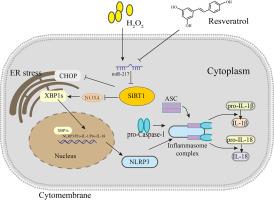miR-217/SIRT1轴在自然衰老的胸主动脉和H2O2诱导的内皮细胞中调节NLRP3炎性体的作用。
IF 4.7
2区 医学
Q2 IMMUNOLOGY
引用次数: 0
摘要
鉴于白藜芦醇(RES)作为抗衰老剂的潜力,本研究探索了其在衰老内皮细胞中通过miR-217/SIRT1轴抑制NOD-、LRR-和pyrin结构域蛋白3 (NLRP3)炎症小体的能力。雄性C57BL/6小鼠连续64周饲喂添加0.04% RES的定制常规饮食。随后,研究了RES对H2O2诱导的人脐静脉内皮细胞(HUVECs)衰老的影响。在H2O2和RES处理或miR-217模拟物和抑制剂转染的HUVECs中,在SIRT1敲除后进行基因表达分析。研究发现,RES降低了衰老胸主动脉的体重,改善了内皮功能,增强了SIRT1表达,抑制了miR-217、NADPH氧化酶4 (NOX4)和NLRP3的表达。此外,RES以剂量依赖的方式显著降低衰老HUVECs中NOX4、X-box结合蛋白1剪接(XBP1s)的表达和活性氧(ROS)的产生。SIRT1敲低通过上调NOX4和XBP1s的表达导致NLRP3炎性体的激活,这一作用被RES预处理部分减弱。RES还抑制H2O2诱导的miR-217的表达。miR-217模拟物促进细胞衰老;然而,RES减轻了这一作用,miR-217抑制剂进一步放大了这一作用。本文章由计算机程序翻译,如有差异,请以英文原文为准。

The role of miR-217/SIRT1 Axis in modulating the NLRP3 Inflammasome in the naturally aging thoracic aorta and in endothelial cells undergoing senescence induced by H2O2
Given resveratrol's (RES) potential as an anti-aging agent, this study explored its ability to inhibit the NOD-, LRR-, and pyrin domain-containing protein 3 (NLRP3) inflammasome through the miR-217/SIRT1 axis in senescent endothelial cells. Male C57BL/6 mice were administered a customized regular diet supplemented with 0.04 % RES for 64 consecutive weeks. Subsequently, the effects of RES on senescent human umbilical vein endothelial cells (HUVECs) induced by H2O2 were evaluated. Gene expression analyses were conducted following SIRT1 knockdown in HUVECs treated with H2O2 and RES, or transfected with miR-217 mimics and inhibitors. The study found that RES reduced body weight, improved endothelial function, enhanced SIRT1 expression, and suppressed the expression of miR-217, NADPH oxidase 4 (NOX4), and NLRP3 in the senescent thoracic aorta. Additionally, RES significantly reduced the expression of NOX4, X-box binding protein 1 spliced (XBP1s), and reactive oxygen species (ROS) production in a dose-dependent manner in senescent HUVECs. SIRT1 knockdown resulted in the activation of the NLRP3 inflammasome by upregulating NOX4 and XBP1s expression, an effect that was partially attenuated by RES pretreatment. RES also suppressed the expression of miR-217 induced by H2O2. The miR-217 mimic facilitated cellular senescence; however, RES mitigated this effect, which was further amplified by the miR-217 inhibitor.
求助全文
通过发布文献求助,成功后即可免费获取论文全文。
去求助
来源期刊
CiteScore
8.40
自引率
3.60%
发文量
935
审稿时长
53 days
期刊介绍:
International Immunopharmacology is the primary vehicle for the publication of original research papers pertinent to the overlapping areas of immunology, pharmacology, cytokine biology, immunotherapy, immunopathology and immunotoxicology. Review articles that encompass these subjects are also welcome.
The subject material appropriate for submission includes:
• Clinical studies employing immunotherapy of any type including the use of: bacterial and chemical agents; thymic hormones, interferon, lymphokines, etc., in transplantation and diseases such as cancer, immunodeficiency, chronic infection and allergic, inflammatory or autoimmune disorders.
• Studies on the mechanisms of action of these agents for specific parameters of immune competence as well as the overall clinical state.
• Pre-clinical animal studies and in vitro studies on mechanisms of action with immunopotentiators, immunomodulators, immunoadjuvants and other pharmacological agents active on cells participating in immune or allergic responses.
• Pharmacological compounds, microbial products and toxicological agents that affect the lymphoid system, and their mechanisms of action.
• Agents that activate genes or modify transcription and translation within the immune response.
• Substances activated, generated, or released through immunologic or related pathways that are pharmacologically active.
• Production, function and regulation of cytokines and their receptors.
• Classical pharmacological studies on the effects of chemokines and bioactive factors released during immunological reactions.

 求助内容:
求助内容: 应助结果提醒方式:
应助结果提醒方式:


